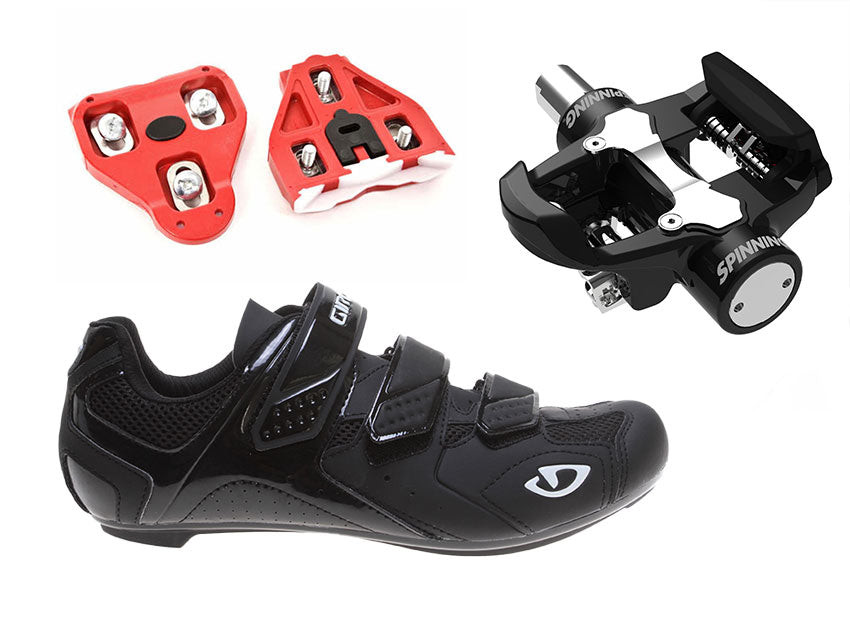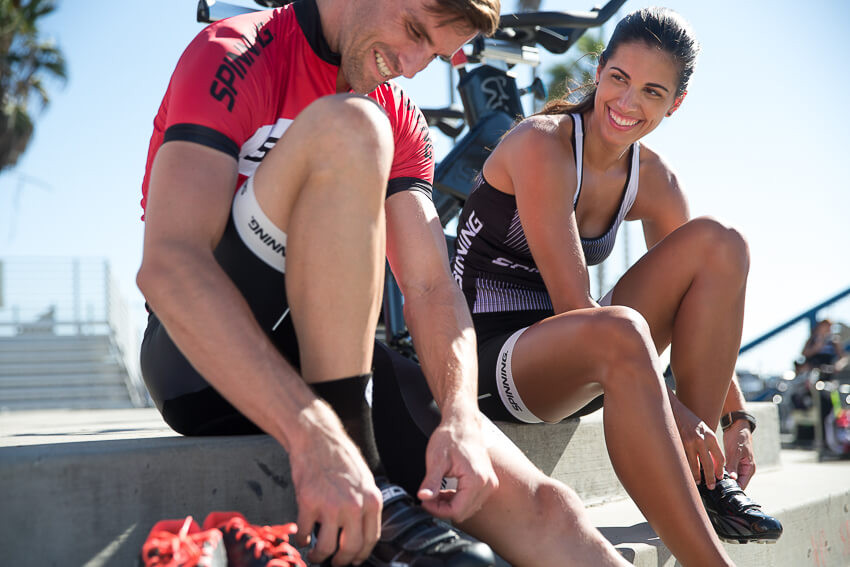Stepping into the world of indoor cycling can be transformative, and one key upgrade to enhance your experience is switching to Indoor Cycling Bike Shoes. Moving away from regular athletic shoes or sneakers to specialized cycling footwear can significantly boost comfort, efficiency, and safety during your workout sessions. Imagine a ride where every pedal stroke feels more powerful and your connection to the bike is seamless – that’s the advantage of using cycling shoes in your indoor cycling classes.
 Spinning
Spinning
Why Indoor Cycling Shoes Matter
Indoor cycling bike shoes are specifically designed to elevate your performance and enjoyment in each class. Unlike flexible athletic shoes, cycling shoes are constructed from lightweight, breathable materials that closely hug your foot. This snug fit maximizes comfort and minimizes slippage inside the shoe. More importantly, they feature incredibly stiff soles. This rigidity is crucial because it allows for superior power transfer to the pedals, ensuring that more of your energy propels the bike forward rather than being lost in the flex of a soft sole. Beyond power, cycling shoes offer a secure and stable connection to the bike, enhancing safety and control throughout your ride.
 Spinning
Spinning
Understanding the Components: Shoes, Cleats, and Pedals
To fully utilize indoor cycling shoes, it’s important to understand the three integral components: the pedals, the shoes, and the cleats. While all standard indoor cycling bikes accommodate athletic shoes with adjustable toe cages and straps, they are also equipped with a clipless pedal system. This system allows you to attach cycling shoes directly to the pedals using cleats. This clipless side is engineered to provide the most efficient, powerful, and secure ride achievable. For a consistently optimal indoor cycling experience, cycling shoes are highly recommended for every class.
 Spinning
Spinning
Because cycling shoes and cleats are often purchased separately, and their compatibility depends on the specific indoor cycling bikes used in your studio, let’s examine each component individually to understand how they function together seamlessly.
 Spinning
Spinning
Choosing the Right Indoor Cycling Shoes for You
Finding the perfect indoor cycling shoes involves a straightforward three-step process:
- Identify Your Studio’s Pedal System: Begin by determining the pedal system used on the indoor cycling bikes at your studio. Most Spinner® bikes are universally compatible with Shimano® SPD® cleats. However, some facilities utilize Spinner bikes equipped with optional dual-sided TRIO® pedals, which accommodate both SPD® cleats and LOOK® Delta cleats. Always confirm with your fitness center to ascertain the pedal system in place.
- Select the Best Fitting Cycling Shoe: The ideal choice for indoor cycling classes, particularly on Spinner® bikes, is Shimano® SPD®-compatible mountain biking (MTB) shoes. These shoes guarantee compatibility with all Spinner® bikes and feature a practical outer sole designed for easy walking both to and from your bike and around the studio. If your studio uses TRIO® pedals, you gain the added option of road cycling shoes that are compatible with LOOK® Delta cleats.
- Choose the Correct Cleats: Select the appropriate cleats that will securely attach your chosen cycling shoes to your bike’s pedals. Continue reading to delve deeper into shoes, cleats, and pedals, and learn how to ensure they work harmoniously for your best ride.
Types of Indoor Cycling Bike Shoes
When selecting indoor cycling bike shoes, you’ll encounter primarily three types, each designed with specific features to match different riding styles and preferences:
MTB Shoes (Mountain Bike Shoes): Mountain bike shoes are robust and versatile, perfectly suitable for both indoor cycling and outdoor trail riding. Critically, MTB shoes are SPD®-compatible, meaning SPD® cleats will easily attach to your shoes and clip into virtually any indoor cycling bike. The SPD cleat’s 2-hole design integrates directly with the shoe sole, allowing for precise foot positioning. This includes the ability to adjust your foot angle (“toe-in” or “toe-out”), offering a customized fit for enhanced comfort and pedaling efficiency.
Road Shoes: Road shoes are engineered for peak performance in outdoor road cycling. They are exceptionally lightweight, even more so than MTB shoes, and feature an incredibly rigid sole with minimal flex. This design maximizes power transfer, making them ideal for high-intensity rides focused on speed and efficiency. Road cycling shoes are compatible with LOOK® Delta cleats. Their 3-hole connection point provides superior stability and a wide range of adjustability for foot placement and alignment, catering to serious cyclists.
Universal Shoes: You may also find “universal” cycling shoes, sometimes labeled as “Road (Universal)” shoes. These are essentially modified road shoes designed to accommodate both Shimano® SPD® and LOOK® Delta cleats. This versatility makes them an excellent choice for cyclists who appreciate the feel and performance of road shoes but require SPD® cleats to match the pedal systems at their preferred indoor cycling studios.
 Spinning
Spinning
Clipless Pedals: Enhance Your Indoor Cycling Experience
To maximize your indoor cycling workout, feeling connected to your bike and pedaling with utmost efficiency is essential. This is where clipless pedals come into play. Often referred to as “clip-in” or “step-in” pedals, clipless pedals allow you to securely fasten your cycling shoes and cleats to the pedals. To clip in, align the cleat on your shoe with the pedal clip and press down firmly. You’ll feel and hear a click as your shoe engages with the pedal. Releasing is just as intuitive – simply twist your heel outwards, away from the bike, to disengage. While all Spinner bikes are compatible with Shimano® SPD® cleats, certain models feature TRIO® pedals, which are also compatible with LOOK® Delta cleats. Always verify with your studio to confirm the type of pedals installed on their bikes.
 Spinning
Spinning
The Role of Cleats in Indoor Cycling Shoes
Cleats are indispensable for connecting your indoor cycling shoes to the bike’s pedals. If you’ve invested in a new pair of cycling shoes and intend to use them at your local studio, you will need to attach cleats to the soles. Cleats come in various styles and designs and are typically sold separately from cycling shoes, allowing you to customize your setup based on your pedal system and preferences.
 Spinning
Spinning
How to Install Cleats on Your Indoor Cycling Shoes
If you are new to cycling shoes and cleats, professional installation is highly recommended. Visiting your local bicycle shop and having experienced technicians install your cleats ensures accuracy and safety. However, if a bike shop isn’t readily accessible, here’s a step-by-step guide to attaching cleats yourself:
- Locate the Ball of Your Foot: Put on your cycling shoes and identify the ball of your foot. The cleat should be positioned directly beneath this area. Proper alignment under the ball of the foot is crucial for maximizing comfort, pedaling efficiency, promoting natural ankle movement, and preventing potential injuries.
- Adjust for Toe-In or Toe-Out: Ensure the cleats are mounted to accommodate your natural foot angle, whether you naturally point your toes slightly inward (toe-in) or outward (toe-out). These adjustments are vital for comfort and injury prevention. Your feet should feel naturally aligned when clipped in, without any twisting or strain in your hips, knees, or ankles as you pedal. A good starting point is to align the cleats straight on the shoes and then adjust as needed based on your body’s feedback.
- Securely Tighten the Cleats: Firmly tighten the cleat screws. Cleats should be snug against the shoe sole and must not shift or rotate once tightened. Loose cleats can compromise power transfer and safety.
- Clip In and Pedal Slowly to Test: After installing your cleats, clip into the pedals and pedal slowly to assess the cleat positioning. Ideally, the ball of your foot should be centered over the pedal, and your natural toe-in/toe-out should feel comfortable and unstrained when you are clipped in. Remember, cycling shoe cleats are adjustable, and fine-tuning may be needed to find your perfect position on the bike.
 Spinning
Spinning
Types of Cleats for Indoor Cycling Shoes
While numerous cleat and pedal systems exist, for indoor cycling, especially on Spinner® bikes, two main types are relevant:
Shimano® SPD® Cleats: SPD® cleats are favored for their compact, straightforward design and broad compatibility. They are designed to clip into the pedals found on nearly all indoor cycling bikes, making them a versatile and reliable choice for most studios.
LOOK® Delta Cleats: LOOK® Delta cleats feature a 3-hole arrangement, offering enhanced stability and adjustability. These cleats are compatible with TRIO® pedals, which are sometimes available on Spinner® bikes, providing a secure and customizable connection.
Shop Now
 Spinning
Spinning
Understanding Float in Indoor Cycling Cleats
“Float” is a term that describes the degree of rotational freedom your foot has while clipped into the pedal. This feature is intentionally designed into cleats or pedals and is measured in degrees, indicating how much your feet can rotate laterally (left and right) while remaining securely connected. Float is crucial as it allows for a more natural and safer pedal stroke in both seated and standing positions, accommodating slight variations in your pedal technique and body mechanics.
It’s important to differentiate float from improperly installed or worn-out cleats. Your cleats should always be firmly attached to your cycling shoe sole. If you notice your cleats twisting excessively or feeling loose, it’s not float; it’s a sign that the cleats are not correctly bolted down. Always double-check and ensure your cleats are securely fastened and do not rotate independently of your shoe.
For further insights into float and cleat adjustment, consulting with professionals at your local bike shop is highly recommended. Even minor adjustments to cleat positioning can significantly impact your comfort and overall indoor cycling experience. Don’t hesitate to seek advice from local experts or your indoor cycling instructor to find the setup that works best for you.
